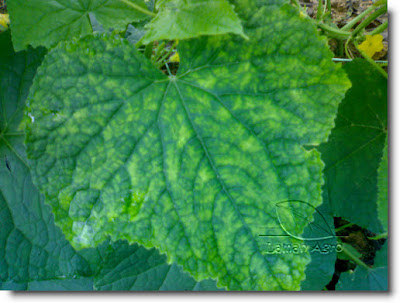
A few of cucumber plants has infected with cucumber mosaic virus with heavy daily rain distribution to this area. The cucumber mosaic virus has one of the broadest host ranges. Cucumbers infected with the cucumber mosaic virus develop a slight yellowing and mottling of the older leaves. Expanding leaves typically become twisted, curl downward, and develop a "shoestring" appearance as a result of a restriction of the leaf surface to a narrow band around the midrib of the leaf. Diseased plants are stunted and produce small quantities of fruit.
The disease affects a number of important vegetables and ornamentals including tomato, pepper, cucumber, melons, squash, spinach, celery, beets, and petunia. A virus distributed world wide, affecting most cucurbits. New growth is cupped downward, and leaves are severely mottled with alternating light green and dark green patches. Plants are stunted, and fruits are covered with bumpy protrusions. Severely affected cucumber fruit may be almost entirely white.
MEANS OF CONTROL
* The virus is readily transferred by aphids and survives on a wide variety of plants. Varietal resistance is the primary management tool, and eliminating weeds and infected perennial ornamentals that may harbor the virus is critical.
* Virus diseases cannot be controlled once the plant is infected. Therefore, every effort should be made to prevent introduction of virus diseases into the garden. Sanitation is the primary means of controlling virus diseases. Infected plants should be removed immediately to prevent spread of the pathogens. Perennial weeds, which may serve as alternate hosts, should be controlled in and adjacent to the garden. Avoid planting tomatoes next to cucurbits, spinach, or other vegetables and flowers susceptible to these diseases. Control of aphids will help reduce the likelihood of cucumber mosaic.
Translation Language
Facebook Badge
Laman Agro Video
Tags
Blogumulus by Roy Tanck and Amanda Fazani
Blog Archive
-
▼
2009
-
▼
November
- Eid al-Adha
- Cucumber plant update
- Cucumber Mosaic Virus (CMV)
- Botanic Pesticide
- Cucumber Diseases and Pests
- Today diary...
- Know Your Pesticide
- Preparing cucumber netting support
- On Hold Chilly
- Preparing Cucumber Support
- Transplant Cucumbers
- Plowing, Rotoring and Ridging
- Land Preparation
- Day 8 Cucumbers
- Cucumbers Variety
- My wife gave birth!
-
▼
November









